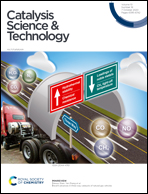Effect of different nitric acid concentrations on manganese/activated carbon-modified catalysts for the catalytic ozonation of toluene
Abstract
In this work, the effect of nitric acid modification on activated carbon (AC) and on properties of Mn/AC ozone catalysts was studied. In addition, the ozone catalytic performance of toluene on catalysts modified with different concentrations of nitric acid was investigated. It was found that nitric acid could greatly increase the oxygen content of the AC support and the acidic oxygenated groups content of the catalysts. The acid-modified catalysts had a higher Mn loading compared to an unmodified sample, and the overall valence of the Mn element increased with the degree of modification. The Mn/AC catalysts modified by fuming nitric acid had a higher toluene conversion rate (84–87%) than the concentrated nitric acid-modified (conversion rate of 63%) and unmodified catalysts (conversion rate of 61%). Among these catalysts, the sample with fuming nitric acid of 43 vol% in acetic anhydride during modification had the highest CO2 and ozone conversion rates compared to catalysts with higher (50 vol%) or lower (33 vol%) nitric acid modification concentration. Furthermore, a new toluene catalytic ozonation intermediates conversion and accumulation mechanism at low temperature is proposed.



 Please wait while we load your content...
Please wait while we load your content...